List of Contents
What is the Access Control Market Size?
The global access control market size is calculated at USD 12.01 billion in 2025 and is predicted to increase from USD 13.03 billion in 2026 to approximately USD 25.15 billion by 2034, expanding at a CAGR of 8.56% from 2025 to 2034. The increasing adoption of IoT and cloud-based technologies is boosting the growth of the access control market.
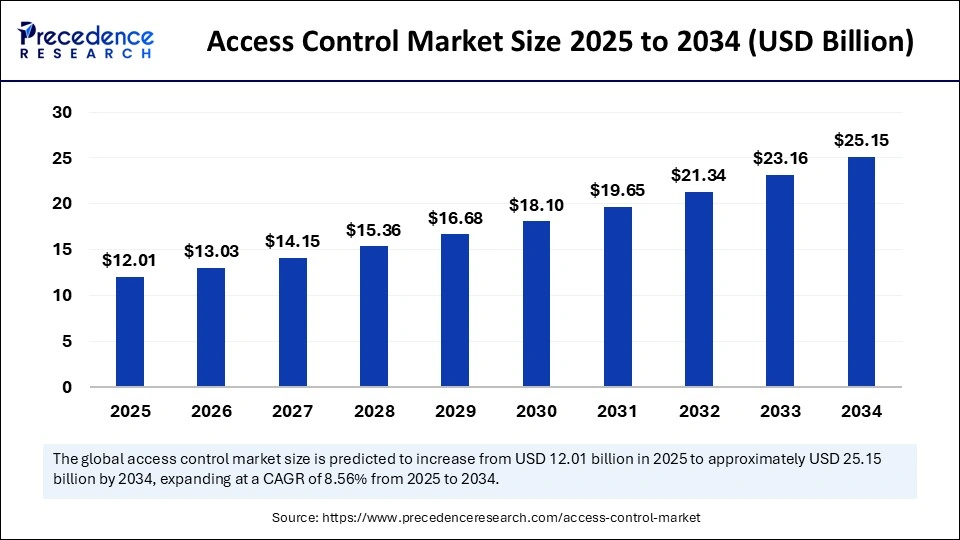
Access Control Market Key Takeaways
- In terms of revenue, the access control market is valued at $12.01 billion in 2025.
- It is projected to reach $25.15 billion by 2034.
- The market is expected to grow at a CAGR of 8.56% from 2025 to 2034.
- North America held the largest market share of 33% in 2024.
- Asia Pacific is expected to grow at a CAGR of 11% from 2025 to 2034.
- By offering, the hardware segment contributed the biggest market share of 44% in 2024.
- By offering, the services segment is expected to grow at the fastest rate between 2025 and 2034.
- By type, the role-based access control (RBAC) segment held the major market share of 48% 2024.
- By type, the mandatory access control (MAC) segment is likely to grow at the highest CAGR during the projection period.
- By end use, the business & enterprise environments segment dominated the market in 2024.
- By end use, the healthcare & life sciences segment is expected to grow rapidly in the coming years.
How does AI Impact the Access Control Market?
Artificial Intelligence (AI) plays an important role in transforming the landscape of the market for access control. AI technology can help boost the efficiency, functions, and reliability of access control solutions. AI-driven tools can track and analyze data that provide insights into patterns and security risks. This can help organizations identify possible threats and make informed decisions. AI technology for authentication provides more improved accuracy than traditional access control systems. AI-driven biometric authentication methods are reliable and accurate because they can detect abnormal patterns, helping save damage from any potential threats. AI and machine learning (ML) together can analyze vast amounts of data to identify specific patterns or trends that help in enhancing security solutions in access control. AI-driven systems help make strategic decisions for security purposes.
Market Overview
Access control is a security measure utilized to protect resources within the computing environment from unwanted access and misuse. The access control market is witnessing significant growth due to the rising incidence of cyber threats and criminal activities across the world. Organizations in private as well as public sectors have realized the importance of protecting their resources and added addition security layers like access control systems. Technological advancements have enhanced the accuracy, efficiency, and reliability of these systems.
The rising adoption of IoT and cloud-based technologies among businesses is a key factor fueling the growth of this market. The rapid pace of urbanization and investments in smart city projects, specifically in emerging countries, is propelling the market's growth. A shift toward hybrid and remote work models requires substantial security measures. This leads to a growing adoption of access control and access management solutions. Key players operating in the market are focusing on innovation and integration of advanced technologies to diversify their product portfolios, which is likely to ensure long-term market growth.
Access Control Market Growth Factors
- The increasing number of cases of cybersecurity threats in physical and digital spaces is a key factor boosting the growth of the access control market.
- The rapid digitization and the rising utilization of smart devices in commercial, residential, and public spaces boost the growth of the market.
- With the growing security concerns, businesses are placing emphasis on improving security and protecting their resources by adopting access control systems on a wider scale, boosting the market's growth.
Market Scope
| Report Coverage | Details |
| Market Size by 2034 | USD 25.15 Billion |
| Market Size in 2025 | USD 12.01 Billion |
| Market Size in 2026 | USD 13.03 Billion |
| Market Growth Rate from 2025 to 2034 | CAGR of 8.56% |
| Dominating Region | North America |
| Fastest Growing Region | Asia Pacific |
| Base Year | 2025 |
| Forecast Period | 2025 to 2034 |
| Segments Covered | Offering, Type, End Use, and Region |
| Regions Covered |
North America, Europe, Asia-Pacific, Latin America, and Middle East & Africa |
Market Dynamics
Drivers
Rising Incidents of Security Breaches
The rising number of incidents of security breaches in digital spaces is a key factor driving the growth of the access control market. The constant looming threat of security breaches is pushing organizations to adopt advanced security solutions, such as access control, to protect their resources. In 2022, the FBI (Federal Bureau of Investigation) reported 847,522 burglaries in the U.S., a significant increase from than previous year. The adoption of access control solutions is rising in the commercial, residential, public, and industrial sectors due to the rising security concerns. Access control solutions provide significant security for organizations. The rise in sophistication of cyber threats in digital space further drives this market's growth.
Restraint
High Initial Costs
The high initial costs associated with setting up access control systems hamper the growth of the access control market. There have been continuous technological advances in access control systems in the last few years. Advanced access control solutions have added features like smart cards, biometrics, smartphone systems, keypads, etc. Installing advanced access control solutions requires substantial investments in hardware and software, which creates barriers for businesses, especially those operating with constrained budgets. Physical key lock access systems are cheaper but unsuitable for the changing technological landscape. Prices of access control systems vary according to features, impacting the purchasing power of businesses.
Opportunity
Demand for Mobile-based Access Control
The rising demand for mobile-based access control solutions creates immense opportunities for key players operating in the access control market. With rising hybrid and remote work models, there is a growing demand for access control systems that can help in access management in such work environments. These access systems can provide temporary access to employees working from different locations through their smartphones for better flexibility and convenience. Mobile applications can also be personalized to suit specific requirements according to the organizations. It can offer multiple entry options through access systems, helping boost the safety of the operations. The chance of widening the scope of applications for this market through such innovations will help the market expand in the forecast period.
- In July 2024, a leading digital technology company, SimonsVoss, announced the launch of AX2Go Mobile Key. This key will enable smartphone-based access control on its range of digital locking components.
Offering Insights
The hardware segment held the dominant share of the access control market in 2024. This is mainly due to advancements in technology and the increased need for security solutions in organizations. The widespread utilization of biometric authentication technologies like facial recognition, fingerprint scanners, and iris scanners further bolstered the growth of this segment. These technologies help enhance organization security by preventing unauthorized access. The demand for hardware has increased with the increased adoption of such systems across different industries.
Meanwhile, the services segment is expected to grow at the fastest rate. The growth of the segment is attributed to the increasing adoption of various access control solutions to improve security. This creates a need for installation and maintenance services. The rising demand for access control systems directly reflects the growth of this segment.
Type Insights
The role-based access control (RBAC) segment led the access control market in 2024. This is mainly due to the increased adoption of role-based access control systems in industries like government, healthcare, and commercial, where certain people need specific access. The RBAC solutions are easily scalable and user-friendly. These solutions enable organizations to allow access to selected people only based on predefined roles, which helps optimize access management.
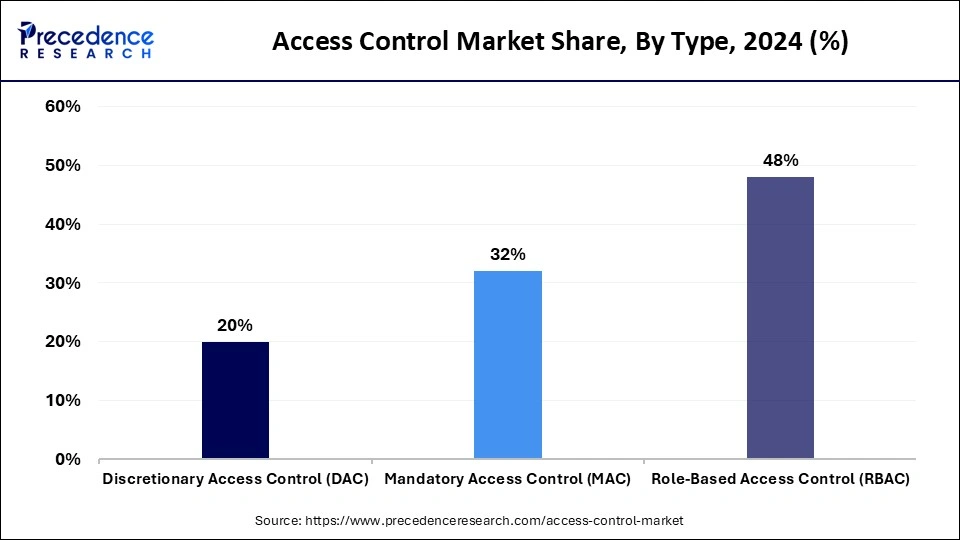
On the other hand, the mandatory access control (MAC) segment is likely to grow at the highest CAGR during the projection period. Stringent regulations regarding the safety and privacy of data and infrastructure encouraged the adoption of MAC in sectors like defense and government. The rising emphasis on data protection further fuels the growth of the segment. MAC offers centralized access control that helps protect infrastructure. The rising need for controlled access to sensitive data further supports segmental growth.
End Use Insights
The business & enterprise environments segment dominated the access control market with the largest share in 2024. This is mainly due to the increased need for efficient access control solutions for data protection and employee management and security. Businesses and enterprises often require access control solutions that are scalable and have the capacity to manage large volumes of users and permissions. With an increase in focus on robust security solutions to protect resources, organizations are investing heavily in developing security infrastructure like access control. The increased adoption of access control solutions across all businesses bolstered the growth of this segment.
The healthcare & life sciences segment is expected to grow rapidly in the coming years. Healthcare data is being more frequently targeted by cyber threats, increasing the necessity for advanced access control solutions. With the expansion of the healthcare and life sciences sectors, the need for security solutions like access controls is rising. With the growing concerns about data security, the demand for scalable and reliable access control solutions in these sectors is rising.
Regional Insights
U.S. Access Control Market Size and Growth 2025 to 2034
The U.S. access control market size is exhibited at USD 2.93 billion in 2025 and is projected to be worth around USD 6.28 billion by 2034, growing at a CAGR of 8.80% from 2025 to 2034.
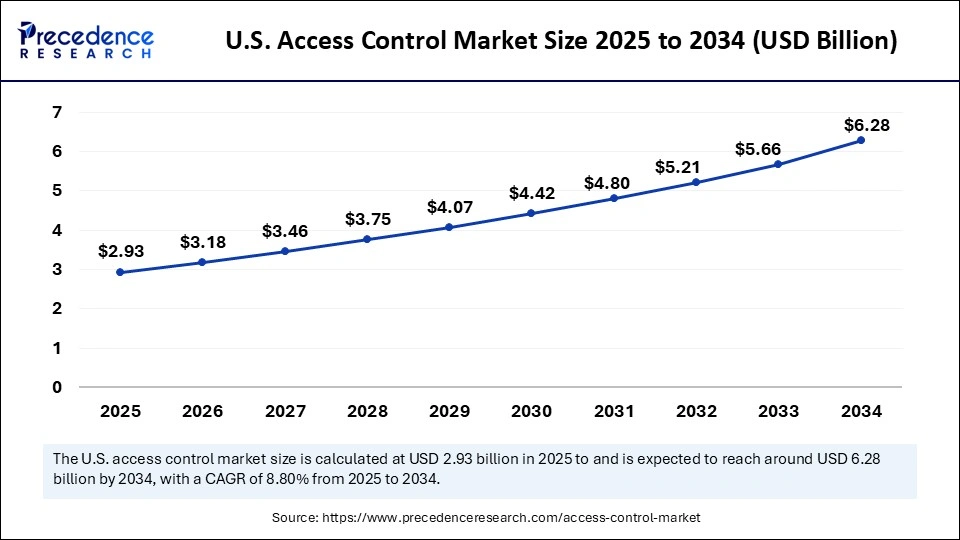
North America held the dominant share of the access control market in 2024. This is mainly due to the increased incidences of crime and security breaches in the last few years. This significantly increased the demand for advanced access control solutions. The high rate of integration of advanced technologies among businesses further bolstered the growth of the market. Access control systems are being widely adopted in private and public sectors alike to enhance the safety of the resources. With the growing number of people working in hybrid and remote work modes, the need for flexible yet robust solutions has increased.
The U.S. plays a major role in the growth of the market in North America. The growing necessity of access control for safeguarding resources is boosting the market's growth in the country. The increasing usage of the Internet of Things (IoT) and cloud devices is boosting the demand for access control and management systems.
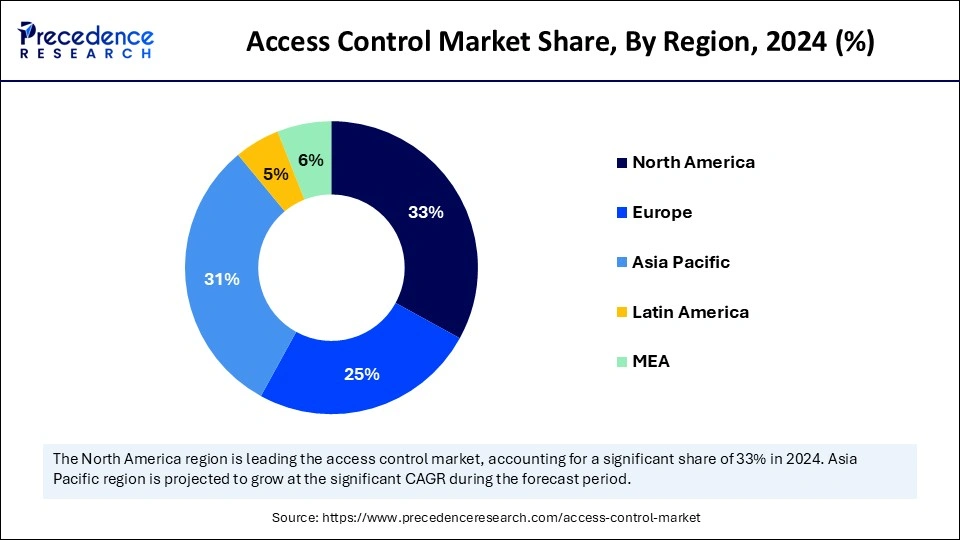
Asia Pacific is projected to witness the fastest growth during the forecast period. The rapid urbanization and the growing development of smart cities in the region are major factors driving the growth of the market. Governments around the region and the private sector are regularly investing in access control solutions to enhance security and protect resources. Access control systems are finding applications in transportation hubs, commercial complexes, public spaces, and even in residential buildings. Countries like India and China play a crucial part in the growth of this market. The Chinese government is focusing on improving security infrastructure to reduce the burden of cybersecurity threats. With the rapid digitization, businesses in India are increasingly adopting IoT and cloud-based solutions, significantly increasing the demand for access control systems.
Europe is expected to witness notable growth during the forecast period. The growth of the access control market in Europe can be attributed to stringent regulations regarding data privacy and safety. European organizations are integrating access control systems due to the growing concerns about the safety of infrastructure. Moreover, there is a significant rise in the adoption of IoT and cloud-based solutions among organizations across the continent, which further supports the market's growth.
Recent Developments
- In April 2025, face biometrics software RecFaces integrated with the Genetec Security Center. This integration is expected to boost efficiency and security as well as automation of physical access control and identity verification.
- In April 2025, ASSA ABLOY announced the acquisition of a US-based manufacturer of access control pedestals, bollards, and innovative mounting solutions, Pedestal Pro. This acquisition aims to strengthen the position of ASSA ABLOY in the market by diversifying its product portfolio.
Access Control Market Companies
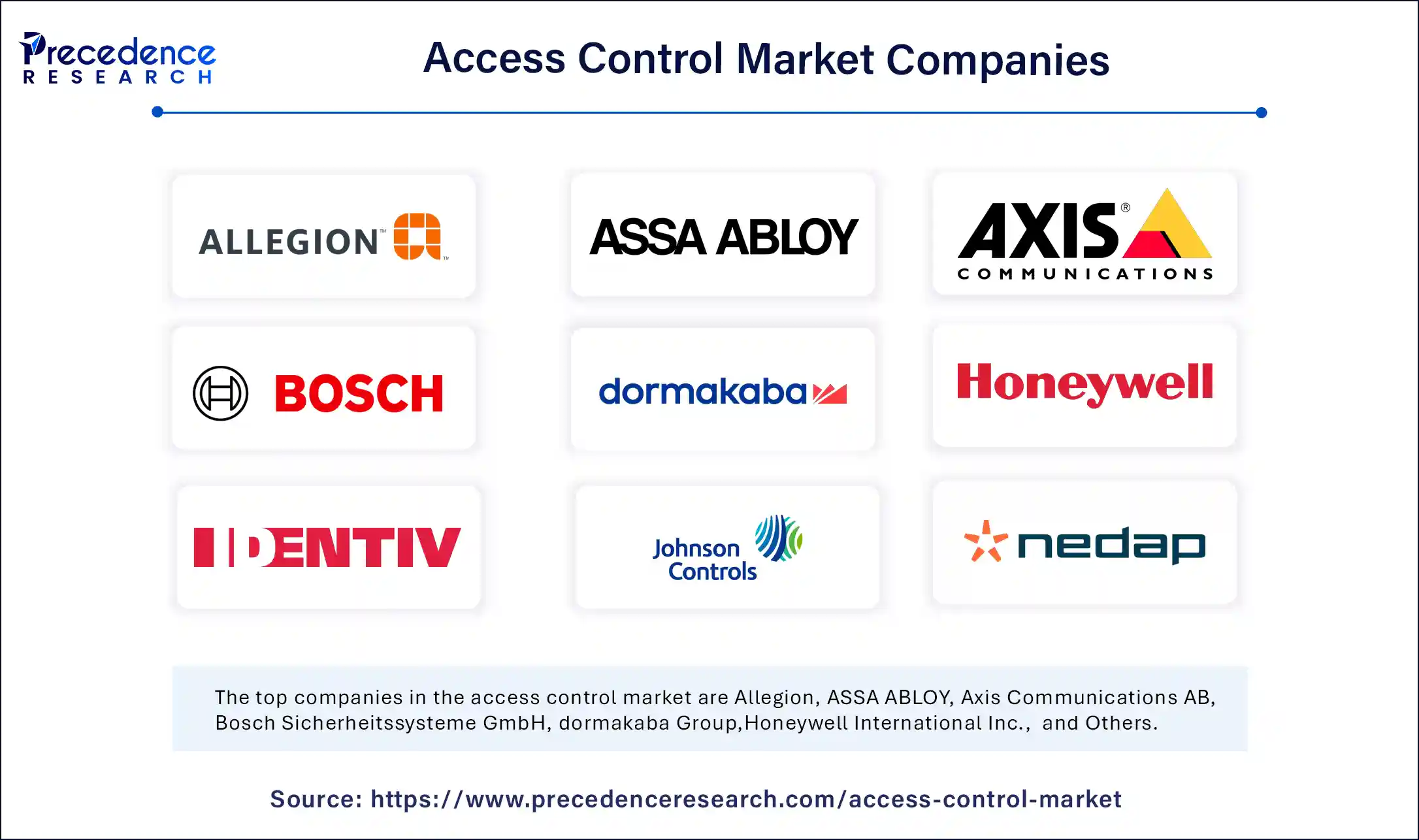
- Allegion
- ASSA ABLOY
- Axis Communications AB
- Bosch Sicherheitssysteme GmbH
- dormakaba Group
- Honeywell International Inc.
- Identiv, Inc.
- Johnson Controls Inc.
- Nedap N.V.
- Siemens
Segments Covered in the Report
By Offering
- Hardware
- Software
- Services
By Type
- Discretionary Access Control (DAC)
- Mandatory Access Control (MAC)
- Role-Based Access Control (RBAC)
By End Use
- Business & Enterprise Environments
- Financial Institutions
- Hospitality & Entertainment
- Retail & Customer-FacingB
- Government & Public Services
- Residential
- Education & Research
- Healthcare & Life Sciences
- Energy & Utility Infrastructure
- Transportation & Logistics
- Others
By Region
- North America
- Europe
- Asia Pacific
- Latin America
- MEA
For inquiries regarding discounts, bulk purchases, or customization requests, please contact us at sales@precedenceresearch.com
Frequently Asked Questions
Ask For Sample
No cookie-cutter, only authentic analysis – take the 1st step to become a Precedence Research client